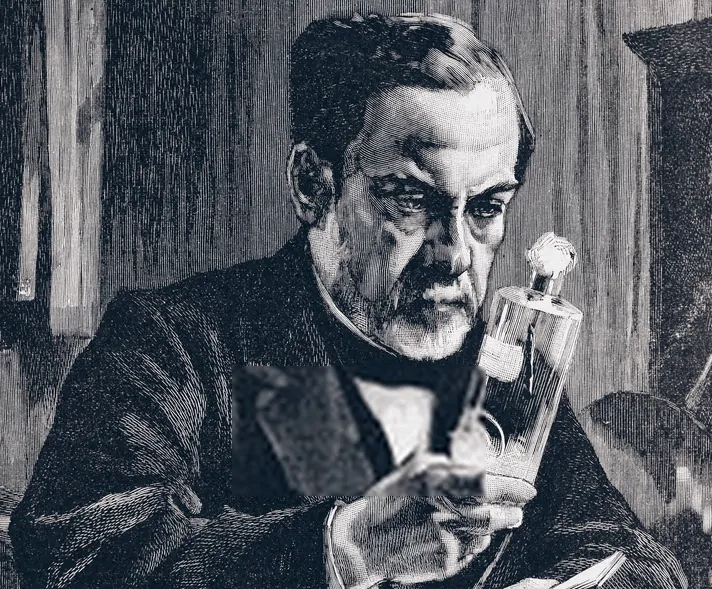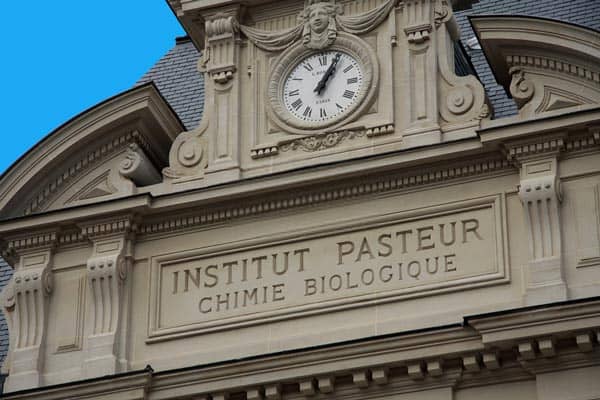
- Born: December 27 1822
- Born in: Dole, France
- Death: September 28 1895
- Nationality: French
- Specialisms: Microbiology and Chemistry
- Religion: Catholic, though did not practice
- Education: École Normale Supérieure
- Experiments: Many, including testing whether sterile broth could generate microbial life
- Inventions: Pasteurisation process
- Director of: Pasteur Institute, which was founded in 1887
- Spouse: Marie Pasteur, nee Laurent (1826-1910)
- Family: 4 daughters, 1 son
- Science: Louis Pasteur’s Most Famous Invention Is the Pasteurization Process
- Science: Pasteur’s Work on Germ Theory Was Revolutionary
- Education: Pasteur’s First Attempt to Study Science was not Successful
- Education: Pasteur was Not a Good Student as a Youth
- Science: The First Vaccine He Invented was for Chicken Cholera
- Science: Pasteur Discovered the Concept of Being Left or Right Handed
- History: Pasteur’s Own Family Life was Blighted by Tragedy
- Science: Pasteur Trialed a Vaccine for Anthrax
- Science: Pasteur’s Experiments Also Paved the Way for Eradicating Diphtheria
- History: He Founded the Paris Pasteur Institute in 1887
- Louis Pasteur Had Obsessive-Compulsive Disorder
- Pasteur Suffered a Stroke in 1868 but Carried on Working
- Pasteur First Tried a Vaccination Against Rabies in 1865
- Pasteur Was Remembered For His Work With the Legion of Honor
- Pasteur Stopped France’s Sickly Silkworm Problems
What did Louis Pasteur Invent? Louis Pasteur’s Most Famous Invention Is the Pasteurisation Process

The first in our series of interesting Louis Pasteur facts reveals what he is most famous for. The process of pasteurisation was developed to stop foods – such as milk – from deteriorating in quality, developing micro-organisms, and making people sick.
Pasteur believed that germs were the root of most illnesses, and that finding a way to reduce them in foodstuffs would result in less illness and a safer food chain. Pasteurisation worked in a different way to sterilisation – which could ruin and spoil foods and affect their taste – and simply used gentle heat techniques to kill off bad bacteria, while leaving the flavours intact.
Pasteur’s Work on Germ Theory Was Revolutionary
For centuries, people believed that germs were spread by bad air, or miasma, or that they could be spontaneously created and spread around. During the Middle Ages, people thought that most illnesses were caused by the four humours: black, red, yellow and white bile that we all had in our systems.
Pasteur challenged this belief, and developed the idea that micro-organisms were the true root of most illnesses and diseases. These cultures were not visible to the naked eye, but could spoil food, make us sick or spread contamination from person to person – through unwashed hands, for instance.
Pasteur’s First Attempt to Study Science was not Successful
When he initially went to college in 1838, Pasteur studied science, but only came 16th in his year. He felt this was not good enough, so went away and studied for a further 12 months, before taking his exams again. The next time, he came 5th in his year and went on to study physics and chemistry.
Pasteur was Not a Good Student as a Youth
This next in our series of Louis Pasteur facts tells us about his aptitude as a student. In his early life, it was noted that Louis was not necessarily a good student, or someone who excelled at the sciences.
In fact, it would seem he excelled more at artistic subjects, and liked to draw and paint above anything else. It is often noted that there is a superior attention to detail in all of his art work and paintings; the same sort of detail he eventually applied to his scientific work.
The First Vaccine He Invented was for Chicken Cholera
This was a severe illness which not only affected chickens, but also other types of fowl too, like turkeys and ducks. The illness could spread rapidly, and was highly contagious.
In 1879, he injected some chickens with bacteria that had been kept in the laboratory over the summer, and found that the chickens did not contract cholera. A new fresh batch of bacteria was grown, and the chickens that had been injected before were injected again, along with a new batch of chickens.
Only the new chickens contracted cholera. Pasteur realised this was the same technique that Edward Jenner had found when he was able to isolate and cure smallpox sufferers in England.
Pasteur Discovered the Concept of Being Left or Right Handed

This next one of our Louis Pasteur facts is one that not many people are aware of, but he did actually discover the notion of being left-handed or right-handed and how this works amongst the general population.
He found that every living creature has molecules in their body which help them twist in either direction and how they twist equates to what “hand” you use for everyday tasks, like writing etc.
Pasteur’s Own Family Life was Blighted by Tragedy
Our next in the Louis Pasteur facts shows how his own life was marred by tragedy. It was not uncommon for families to lose children in the 19th century, and infant mortality rates were high.
Despite Pasteur’s medical advances, he could not stop typhoid claiming the lives of two of his own daughters. Typhoid is a disease which is usually carried by bad food or contaminated water, and it seems especially sad given all his work on germ theory.
Pasteur Trialed a Vaccine for Anthrax
We’re familiar with how dangerous anthrax can be in our modern age, and it is now used as a chemical weapon. It is a contagion that is fatal to animals and humans alike.
Robert Koch was the German scientist who had successfully isolated the bacteria that caused the illness, and Pasteur developed a vaccine against it, reporting at the time that he had successfully immunised 31 cattle against contracting anthrax.
Pasteur’s Experiments Also Paved the Way for Eradicating Diphtheria
Louis Pasteur facts also show us how he, in conjunction with two other scientists, Emile Roux and Alexandre Yersin, discovered how the illness could flood the body with toxins, which could then prove fatal.
Isolating these toxins and viewing how they worked was key to developing a vaccine. In today’s world, 85% of all children are vaccinated against this killer illness, meaning it is almost eradicated.
He Founded the Paris Pasteur Institute in 1887

This remarkable building is also where his remains lie. In 1940, Nazi soldiers approached the man who guarded his tomb, Joseph Meister, and ordered him to open it up so they could look at Pasteur’s remains.
Meister would not comply with the request, and sadly took his own life after coming under increasing pressure from the soldiers. As we’ll see further on, Meister had good reason to feel this way.
Louis Pasteur Had Obsessive-Compulsive Disorder
The next in our series on Louis Pasteur facts relates to his own health. Possibly as a result of the years of research and study he did into germs and how they can multiply, Pasteur had a morbid fear of shaking anyone’s hand.
He was (understandably) frightened he might catch an illness from them. Based on what we know today, it is more than likely that, had he been alive today, he would have been diagnosed with obsessive-compulsive disorder.
Pasteur Suffered a Stroke in 1868 but Carried on Working
At a time when many people died from less serious ailments, it is remarkable that even in 1868 after Louis Pasteur suffered a stroke and was rendered partially paralysed, he refused to give up. Pasteur carried on with his studies and work. In fact, he lived for a further 27 years after the illness struck.
Pasteur First Tried a Vaccination Against Rabies in 1865
Pasteur had already discovered that microbes of the rabies illness were present in the saliva of the victim, and he had successfully managed to isolate this and examine it under a microscope.
He felt certain that by taking tissue from dogs that had been infected with the illness, he could then try and create some sort of vaccine. He did this, but the biggest step – and the one he was scared to take – was to try and find a human to trial it on.
If it failed, he would have been in a great deal of trouble. In the end, a young man called Joseph Meister came forward. Meister had been infected with rabies and was certain to die. Pasteur gave him 12 shots of his vaccine over a weekly period. Joseph recovered, and credited Pasteur with saving his life. When Pasteur died, Joseph became a guardian of his tomb.
Pasteur Was Remembered For His Work With the Legion of Honour
This is a prestigious French honour given to people who have created remarkable legacies in their field of expertise, so it seems only right that Pasteur was given this accreditation. He was awarded the honour in 1853 for his work, though he had many more years of important discoveries in front of him at this time.
Pasteur Stopped France’s Sickly Silkworm Problems
The final in our series on Louis Pasteur facts tells us about how he also helped to stop a problem with dying silkworms. In 1865, the French Agriculture Department asked him if he could help work out why so many silkworms were dying, and decimating the silk industry.
Pasteur found out how to examine and spot an unhealthy silkworm by looking at it under a microscope. He was able to pick out which worms were healthy and which weren’t, and to show the farmers how to spot them too.
He discovered that diet and temperature affected them too, and his results meant that farmers could take better care of their worms and help their industry to recover over the following years.
Louis Pasteur Facts – Facts about Louis Pasteur Summary
 Facts about Louis Pasteur show us that although his own life was blighted by illness, he was able to carry on his good work. He was not an especially brilliant scholar, preferring arts to sciences, but studied hard and ended up excelling in his fields of physics, chemistry and biology. He discovered germ theory, and helped us to understand why food and drink turns bad, but he also suffered from obsessive-compulsive disorder.
Facts about Louis Pasteur show us that although his own life was blighted by illness, he was able to carry on his good work. He was not an especially brilliant scholar, preferring arts to sciences, but studied hard and ended up excelling in his fields of physics, chemistry and biology. He discovered germ theory, and helped us to understand why food and drink turns bad, but he also suffered from obsessive-compulsive disorder.
Was this page helpful?
Our commitment to delivering trustworthy and engaging content is at the heart of what we do. Each fact on our site is contributed by real users like you, bringing a wealth of diverse insights and information. To ensure the highest standards of accuracy and reliability, our dedicated editors meticulously review each submission. This process guarantees that the facts we share are not only fascinating but also credible. Trust in our commitment to quality and authenticity as you explore and learn with us.
